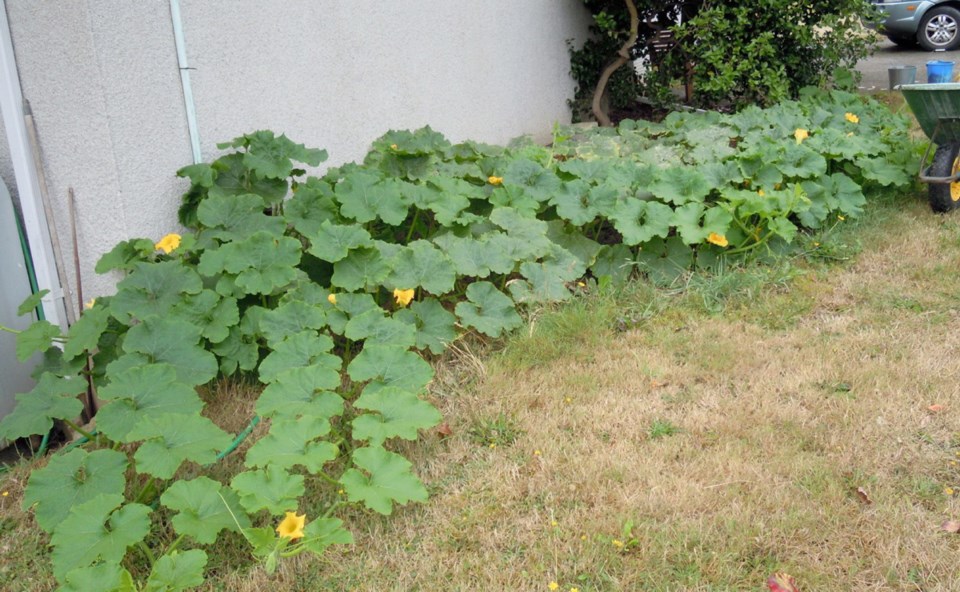Dear Helen: Last summer, a mystery squash type plant appeared in my garden. It grew to around six metres long and produced small, delicious fruits that we enjoyed stir-fried with onion and garlic. I had to keep the small fruits covered up with leaves because the deer liked them too. I have identified them as Ronde de Nice zucchini. I’ve saved seeds for planting this year and hope they grow and produce with equal success.
R.S.
If all goes well, you’re on your way to creating your own strain of Ronde de Nice, a small, round French heirloom variety of zucchini. The seeds you harvested should germinate well as long as you took them from fruits that were allowed to mature beyond the harvesting stage and left until the skins had hardened. Harvested seeds need to be thoroughly dried before storing in a uniformly cool, dry place.
Another issue with saving squash seeds is a possible cross-pollination of your vine’s flowers with another, compatible plant.
Summer and winter squashes, and pumpkins, fall into four main Curcubita species. Your Ronde de Nice, along with all other zucchini varieties, are in the Curcubita pepo group, which also includes Halloween type (common) pumpkins and Acorn, Delicata, Spaghetti, Scallopini and Crookneck squashes. All varieties within this group will cross. There will also be some crossing between members of the C. pepo group and Butternut squash (a different species).
A mixing of pollen among these compatible plants does not affect the current crop. The results will appear in the seeds, which will be of mixed parentage. They won’t produce precisely the same plant and fruit you had hoped to duplicate. That mixed parentage could take the resulting plants in a variety of different directions. A random crossing could produce something superb; it could also result in unpalatable fruits.
Cross-pollination will be an issue for you only if compatible squash or pumpkin plants were growing in the vicinity. Research indicates a separation of around 150 metres is needed to prevent possible crossing.
Dear Helen: My amaryllis bulb appears to be having a baby. A little side sprout appeared for the first time last year, alongside the main bulb. Should I be doing something with it?
K.G.
It is entirely normal for a fairly mature amaryllis bulb to develop an “offset” or baby bulb alongside it — especially in pots that offer a little room between the bulb and the pot rim. I’ve seen amaryllis bulb groupings in pots where the “babies” have been allowed to develop and grow to blooming size. Theoretically, one could end up with a pot filled with flowering amaryllis bulbs.
That said, what most people do is sever the baby bulb cleanly from the mother bulb and pot it separately for a new plant on its own. Do this when the offset has bulked up enough to handle easily. Leave the top one-third of an amaryllis bulb exposed above the soil line when potting.
Dear Helen: We cannot think of a reason for our 27-year old Asian pear tree to produce fruit that tasted mushy and gritty last year. In all previous years the pears were firm, even-textured, and sweet. Any ideas?
E.F.
Asian pears have a naturally crisp, grainy texture. Problems with excess grittiness and other degradations in flesh texture can most often be traced to missing the ideal harvesting time.
You will have become familiar over the years with the fruiting pattern of your tree, and have been able to pick the pears at peak quality. Last year, however, brought us an odd summer with far more mixed weather than usual. I noticed that some trees began ripening fruit surprisingly early. If you had been calculating a harvest at the usual time, it was possible that you missed picking at the fruit’s prime.
As weather patterns continue to change, we can expect more unusual ripening times in our garden fruits. It’s always a good idea to begin watching for signs of ripening and taste-testing early, to be sure of catching the ideal harvesting window.
When an apple or pear detaches easily when lifted gently and twisted slightly, the fruit is ready to pick. With your pears, watch also for the first hint of lightening in the skin colour. A taste test is the final confirmation of the perfect picking time.
It may be that in future years an earlier picking will be needed. Left too long on the tree, the fruit will begin to lose its texture quality.



